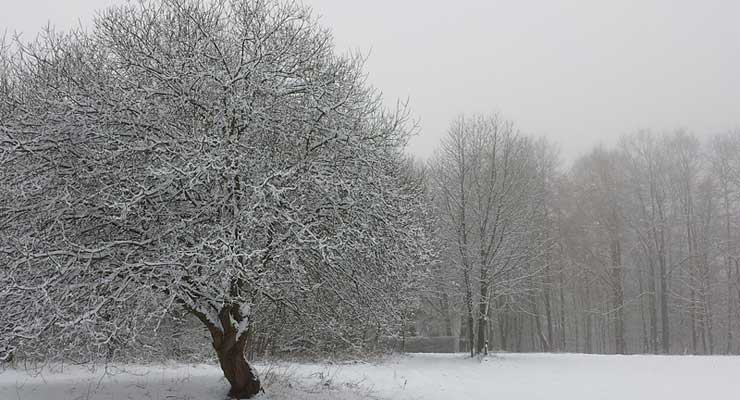
Winter can be tough on trees here in Connecticut, with wind, ice and heavy snow loads, not to mention frigid temperatures. But with proper preparation, your trees can make it through the winter unscathed.
Here are the things we recommend you do before winter sets in, as well as things to keep in mind throughout the coldest months of the year to keep your home and loved ones safe from winter tree damage.
To make it even easier for you, you can download our Winter Tree Care Tips.
And if your tree has been damaged by a winter storm, click here to find out what you should do.
Get Ready For Winter
- Check all of your trees for potentially unsafe branches or tree trunks. If anything looks unsafe (see our article on Identifying Hazardous Trees), give us a call.
- Any dead, damaged or diseased branches should be removed before winter weather can cause them to break.
- If any tree limbs, especially larger ones, hang over your house, car or sidewalk, consider cabling or bracing to keep them stable through the winter. You could also prune them off.
- If your trees have cables and braces in them, the hardware should be inspected every few years to be sure it’s intact, in good condition and that nothing needs to be adjusted or replaced due to the tree’s growth. Winter is a good time for that inspection.
- Install temporary or permanent rope, cable or twine supports in multi-stemmed shrubs that are susceptible to snow and ice loads. Don’t forget to remove these temporary supports in the spring.
Prune While Trees Are Dormant
- Do not prune your trees late in the fall. Doing so forces the tree to put out new growth which can easily be killed by an early frost or freeze, damaging and disfiguring the tree. Wait until all the leaves have fallen and the tree enters dormancy.
- After the leaves have dropped in fall, it’s easier to see the structure of your trees and determine whether or not pruning is required to keep your trees safe and looking their best.
- Winter pruning can also avoid spreading some serious diseases that are active and spread easily during the spring and summer growing seasons, such as Dutch elm disease and fire blight.
- Late winter is a great time to prune, contain or rejuvenate high profile, overgrown plants as they’ll be able to recover quickly in spring with new growth. This will also minimize the negative aesthetic issues that can be associated with rejuvenating plants. But be sure to wait until the risk of single-digit temperatures has passed.
- This is also the time to prune fruit trees to maximize fruit production and minimize fungal and parasitic attacks on the tree.
Check for Deer and Rodent Damage
- Check occasionally during the winter for signs of rodent damage. Use bait, enclosures or repellents as necessary. You’ll find more details on preventing rodent damage in this article.
- Deer can do enormous damage during the winter; when they’re hungry enough they’ll eat almost anything. Use deer spray, fencing or netting to protect your prized trees and shrubs. For more information, see our article on preventing winter deer damage.
Don’t Let Snow Build Up
- Wet, heavy snow and ice can easily break tree branches, especially on evergreens. Avoid heavy snow accumulation on shrubs and smaller evergreens by regularly (but gently!) removing snow after a significant snowfall.
- If you’re concerned about branches that are bending to the ground on larger trees, remove the snow load on the branches you can easily reach. Please don’t use a ladder or climb the tree; call us to take a look and, if necessary, we’ll remove the snow using the proper safety equipment.
- Be careful not break the branches while clearing off snow cover. Lightly brush snow off the branches with your hand or a broom, pushing gently upward and sweeping towards the trunk.
- Don’t shake snow-covered branches or hit them with a broom or rake (yes, we’ve seen it happen!). The branches are likely to break if you do that.
Protect Shrubs and Trees
- Some shrubs, particularly broad-leafed evergreens like rhododendron, can easily shrivel up in the cold, dry winter wind. Protect them with a burlap wrap or spray with an anti-dessicant. Keep in mind that the weather must be above freezing to spray and you may need to apply it several times over the winter.
- Ornamental trees with thin bark and young or newly-planted trees can be susceptible to sunscald when exposed to harsh sunlight after the leaves have fallen. Protect them with trunk wrapping.
- The needles on pine trees and other evergreens can turn brown over winter. We describe how to prevent this in our article on winter browning.
- You can learn more about using burlap to protect your plants in our article on How to Protect Trees and Shrubs From Winter Weather.
- Salt damage is common in areas where salt is used to keep roads, drives and walkways clear of ice. The worst damage occurs to sensitive tree species planted near heavily salted roads with high traffic, especially when they lie downhill, downwind, or have poor drainage. On your own property, we recommend using a less harmful product such as CMA or IcebanTM, and mixing it with inert materials like sand. For more information, see our article on winter salt damage.
- Snow falls. More falls. And then more. And the snow banks pile up. But what happens to the shrubs and trees planted near those huge mounds of snow? We show you how to prevent the chemical and structural damage that typically comes with snow banks in this article.
Do Larger Jobs in Winter
- Here in Connecticut, the ground often freezes in winter so we can bring in heavy equipment without damaging your landscape, resulting in lower costs, faster work and better outcomes. This is especially true for large tree removals.
Continue Watering Newly Planted Trees
- During the winter, we often have alternating periods of freezing weather and warmer temperatures. Check your new trees during those warm spells. If the ground is clear of snow cover and dry, water thoroughly. As long as the ground isn’t frozen, the tree can take up moisture to keep it hydrated through the winter.
Inspect Regularly
- It’s especially important to inspect your trees for structural problems during the winter. Broken branches, split trunks, codominant stems and other issues can quickly go from unsightly to dangerous when you throw in ice, snow and wind.
- If you see something you’re not sure about, call us for a no-cost inspection of your landscape by one of our Certified Arborists. Winter is a great time for these inspections.
Plan Ahead
- Plan your landscape needs before the spring “rush” to ensure the best service and the best plant material if you will be installing plants.
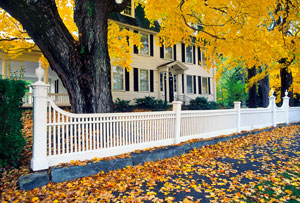 Fall is the perfect time to help your trees recover from the heat and lack of water they probably experienced over the summer. Stressed trees are more susceptible to pests, disease, and winter damage so now’s the time to make sure your trees enter the harsh winter months in the best health possible.
Fall is the perfect time to help your trees recover from the heat and lack of water they probably experienced over the summer. Stressed trees are more susceptible to pests, disease, and winter damage so now’s the time to make sure your trees enter the harsh winter months in the best health possible. Have your fruit trees stopped producing fruit? Do you have disease or insect problems on your fruit trees? Has the tree grown too tall to safely harvest the fruit?
Have your fruit trees stopped producing fruit? Do you have disease or insect problems on your fruit trees? Has the tree grown too tall to safely harvest the fruit?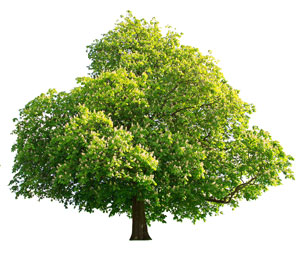 March marked the start of our transition from winter to spring. Now that the snow is gone, it’s a good time to examine your trees for winter damage. We often expect our trees to be self sufficient and tend to neglect their well-being.
March marked the start of our transition from winter to spring. Now that the snow is gone, it’s a good time to examine your trees for winter damage. We often expect our trees to be self sufficient and tend to neglect their well-being.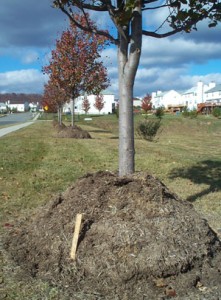
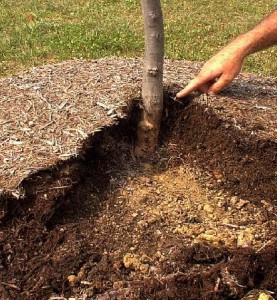

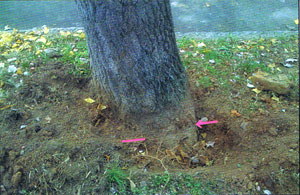 Avoid tree instability issues when having landscaping done or building a new house. All too often people bring in topsoil or fill and bury the trunk flare of existing trees which will result in a stem-girdling root which destabilizes the tree. You should always be able to see the sweeping radius from the tree trunk to the beginning of the root system. If the tree appears to grow straight out of the ground after backfilling then you have covered the trunk flare and are at risk for it to die. As much as I like to come out and remove dead trees for you lets not induce the death onto good trees we want to keep.
Avoid tree instability issues when having landscaping done or building a new house. All too often people bring in topsoil or fill and bury the trunk flare of existing trees which will result in a stem-girdling root which destabilizes the tree. You should always be able to see the sweeping radius from the tree trunk to the beginning of the root system. If the tree appears to grow straight out of the ground after backfilling then you have covered the trunk flare and are at risk for it to die. As much as I like to come out and remove dead trees for you lets not induce the death onto good trees we want to keep.
 Six Good Reasons NOT to “Top”
Six Good Reasons NOT to “Top”

